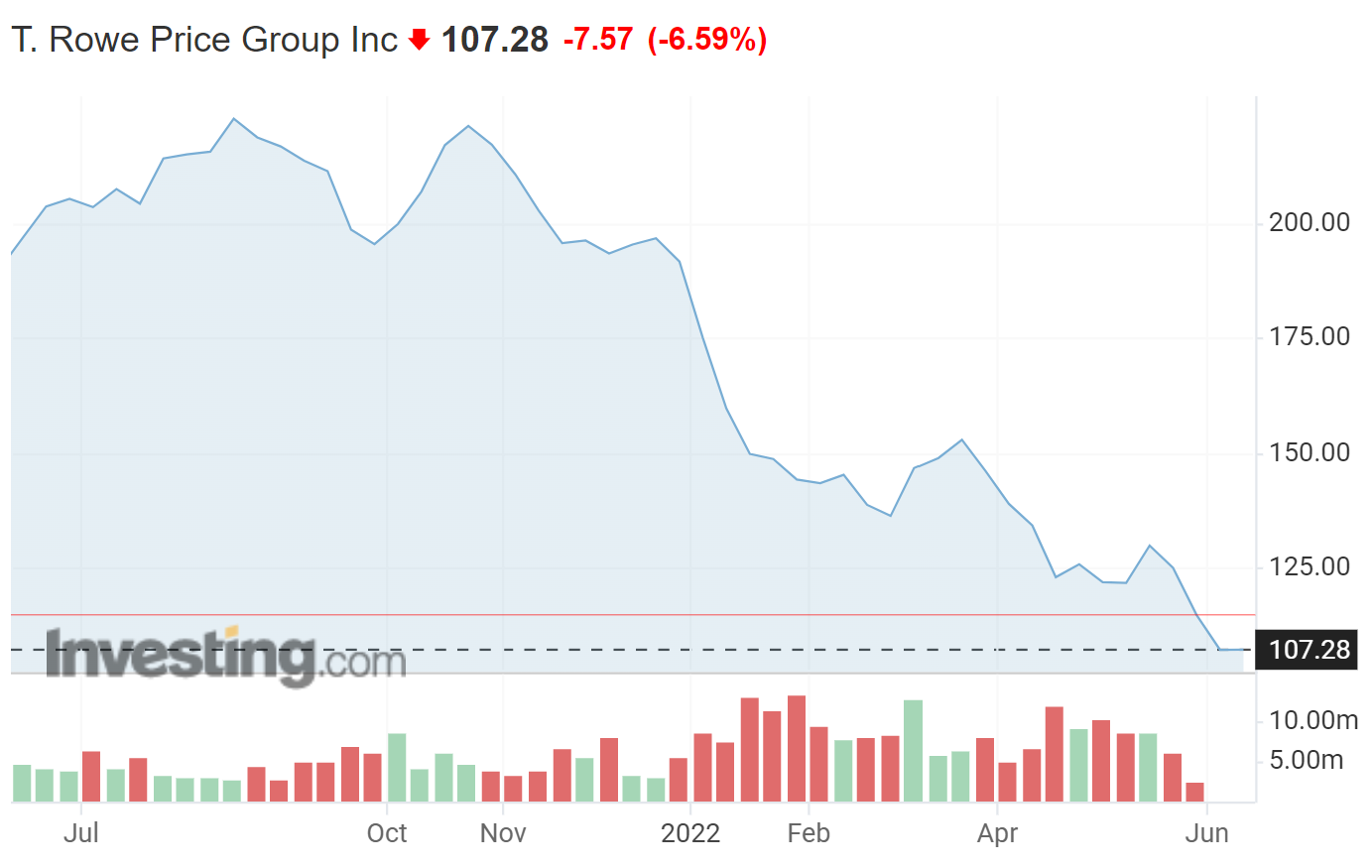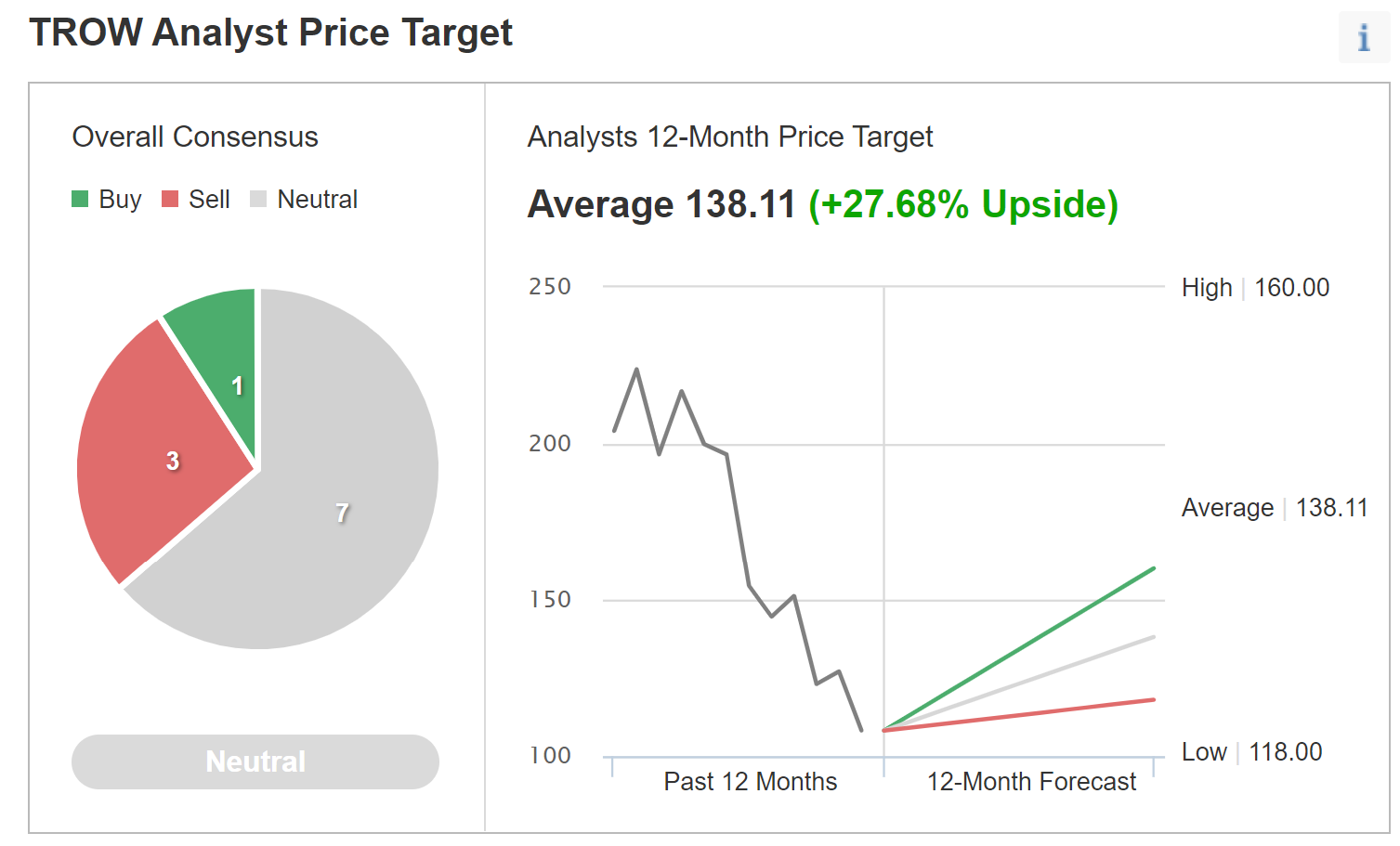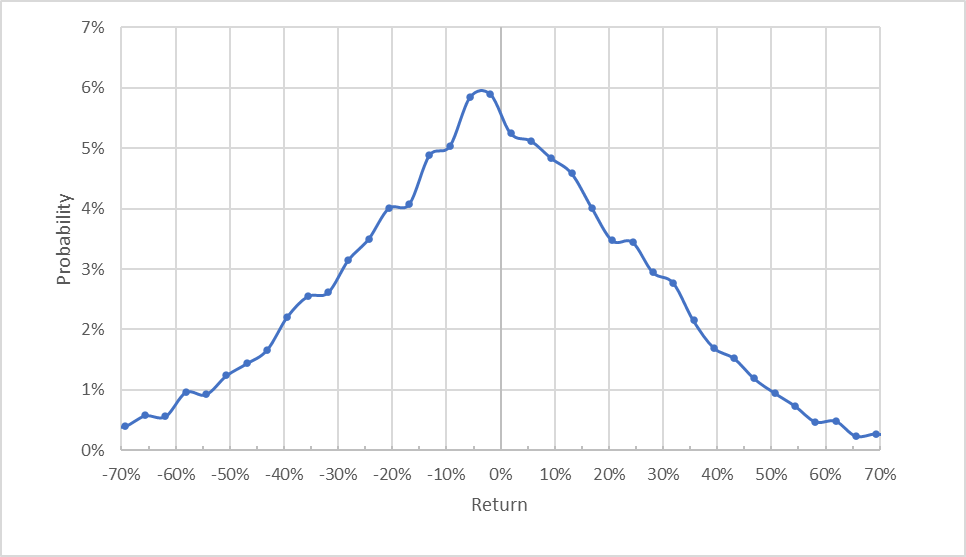- T. Rowe Price has fallen more than 50% from the 12-month high closing price
- The P/E ratio is at its lowest point in more than 10 years
- Wall Street consensus is neutral, with a 12-month price target that is 25% above the current share price
- The market-implied outlook to the end of 2022 is neutral
- For tools, data, and content to help you make better investing decisions, try InvestingPro+
T. Rowe Price (NASDAQ:TROW) is the 16th-largest asset manager in the U.S., with about $1.4 trillion in assets under management. The company manages an array of mutual funds, as well as providing advisory services to individual and institutional investors.
When market’s fall, a money manager’s assets also decline, beyond the effects of asset outflows. Falling assets under management translates to reduced earnings for asset managers because of AUM-based fees. The question, of course, is how the market prices in the probabilistic expectations of future asset flows and market conditions.
Shares in the Baltimore-based financial services giant have fallen 52% from the 12-month high closing price of $223.87, on Aug. 31, 2021, to the current level. Q1 and expected Q2 earnings per share are 21% and 25% below the recent high EPS of $3.31 per share for Q2 of 2021, reported on July 29.

Source: Investing.com
TROW’s earnings are obviously on a downward trajectory, but it is worth noting that the Q1 EPS was 40% above the Q1 2019 and Q1 2020 EPS (which were equal). The consensus outlook for EPS in the coming quarters has a minimum value for Q2 of 2022, at $2.48 per share, which is higher than the EPS for any quarter in 2019 and for three out of four quarters in 2021.

Source: E-Trade. Green (red) values are amounts by which quarterly EPS beat (missed) the consensus expected value.
With a much higher decline in share price than in earnings, the P/E ratio for TROW is the lowest it has been for more than a decade. The current P/E is 9.3. The lowest P/E over the past 10 years was 11.1, in mid-2017.

Source: Macrotrends.com
TROW is a dividend aristocrat, with 36 consecutive years of dividend increases. The current yield is 4.18%, and the 3-, 5- and 10-year dividend growth rates are 15.8%, 15.2%, and 13.3% per year, respectively. The payout ratio is quite low, at 36%.
On March 4, 2022, I maintained a buy/bullish rating on the stock. At that time, TROW was already down about 37% from the 12-month high. Since then TROW’s price return is -22.3%, as compared to a -12.6% for the S&P 500. The sharp drop in the US equity market and continued asset outflows from T. Rowe Price contributed to a substantial sell-off in the shares.
In early March, the Wall Street analyst consensus rating for TROW was neutral, albeit with a consensus 12-month price target that was about 18% above the share price at that time. In addition to considering the fundamentals and the Wall Street consensus outlook, I also rely on the consensus view from the options market, the market-implied outlook. In early March, the market-implied outlook was bullish to the middle of 2022 and neutral for the period through the end of the year.
For readers who are unfamiliar with the market-implied outlook, a brief explanation is needed. The price of an option on a stock is largely determined by the market’s consensus estimate of the probability that the stock price will rise above (call option) or fall below (put option) a specific level (the option strike price) between now and when the option expires. By analyzing the prices of call and put options at a range of strike prices, all with the same expiration date, it is possible to calculate a probabilistic price forecast that reconciles the options prices. This is the market-implied outlook. For a deeper explanation and background, I recommend this monograph published by the CFA Institute.
With the additional declines for TROW and in the broader market, along with surging inflation, I have calculated an updated market-implied outlook and compared this with the current Wall Street consensus outlook in revisiting my overall rating.
Wall Street Consensus Outlook For TROW
E-Trade calculates the Wall Street consensus outlook for TROW by aggregating the views of nine ranked analysts who have published ratings and price targets over the past 3 months. The consensus rating is neutral, as it has been over almost all of the past 12 months, and the consensus 12-month price target is 22.8% above the current share price. Even though the 12-month price target has fallen from $168.39 in March to $132.89 today, the expected 12-month return implied by the price target has increased by a small amount.

Source: E-Trade
Investing.com’s version of the Wall Street consensus outlook is calculated using ratings and price targets from 11 analysts. The consensus rating is neutral, consistent with E-Trade, but the consensus 12-month price target is 27.7% above the current share price.

Source: Investing.com
The Wall Street consensus outlook suggests that TROW has gotten oversold, even considering the potential for further market declines.
Market-Implied Outlook For TROW
I have calculated the market-implied outlook for TROW for the 6.1-month period from now until Dec. 16, 2022, using the prices of put and call options that expire on this date. I chose to analyze this specific expiration date to provide a view to the end of the year. The level of options trading activity on TROW is low, reducing the overall confidence in the representativeness of the market-implied outlook.
The standard presentation of the market-implied outlook is a probability distribution of price return, with probability on the vertical axis and return on the horizontal.

Source: Author’s calculations using options quotes from E-Trade
The outlook for the next six months is generally symmetric, with comparable probabilities of positive and negative returns, although the peak in probability is slightly tilted to favor negative returns. The maximum probability corresponds to a price return of -3.5% for this period. The expected volatility calculated from this distribution is 42% (annualized).
To make it easier to directly compare the relative probabilities of positive and negative returns, I rotate the negative return side of the distribution about the vertical axis (see chart below).

Source: Author’s calculations using options quotes from E-Trade. The negative return side of the distribution has been rotated about the vertical axis.
This view shows that the probabilities of negative returns are consistently slightly higher than the probabilities of positive returns of the same magnitude.
Theory suggests that the market-implied outlook will tend to have a negative bias because investors, in aggregate, are risk averse and thus tend to overpay for downside protection (e.g. put options). There is no way to measure the magnitude of this effect, but the expectation for such a bias suggests that this market-implied outlook be interpreted as neutral.
Summary
TROW is currently trading at about a 50% discount relative to the trailing 12-month high closing price. Although corporate earnings have fallen relative to last year they remain fairly high compared with previous years.
The current valuation is low, with a P/E that is meaningfully below the lowest value over the past decade. The company’s long track record of dividend growth also inspires considerable confidence.
The Wall Street consensus rating for TROW is neutral, although the consensus 12-month price target is about 25% above the current share price. Combined with TROW’s historically-reliable dividend, the expected 12-month total return is around 29%. A neutral rating with such a high expected return suggests that the shares are oversold. The market-implied outlook to the end of the year is neutral, with an expected volatility of 42% (annualized). I am maintaining my bullish/buy rating on the stock.
***
Interested in finding your next great idea? InvestingPro+ gives you the chance to screen through 135K+ stocks to find the fastest growing or most undervalued stocks in the world, with professional data, tools, and insights. Learn More »
